C-5 Galaxy
| C-5 Galaxy | |
|---|---|
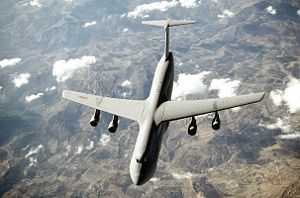 |
|
| Role | Strategic airlifter |
| Manufacturer | Lockheed |
| First flight | 30 June 1968 |
| Introduction | June 1970 |
| Status | Operational Active: 33 Reserve: 45 ANG: 30[1] |
| Primary user | United States Air Force |
| Produced | C-5A: 1968-1973 C-5B: 1985-1989 |
| Number built | 131 (C-5A: 81, C-5B: 50) |
| Unit cost | US$167.7 million (C-5B) |
The Lockheed C-5 Galaxy is an American military transport aircraft built by Lockheed. It was designed to provide strategic heavy airlift over intercontinental distances and to carry outsize and oversize cargo. The C-5 Galaxy has been operated by the United States Air Force since 1969 and is one of the largest military aircraft in the world.
Contents |
Development
Background
In 1961, several aircraft companies began studying heavy jet transport designs that would replace the C-133 transport and complement C-141 Starlifters. In addition to higher overall performance, the US Army wanted a transport with a larger cargo bay than the C-141, whose interior was too small to carry a variety of their outsized equipment. These studies led to the "CX-4" design concept, but in 1962 the proposed six-engine design was rejected, because it was not viewed as a significant advance over the C-141.[2]
By late 1963, the next conceptual design was named CX-X. It was equipped with four engines, instead of six engines in the earlier CX-4 concept. The CX-X had a gross weight of 550,000 pounds (249,000 kg), a maximum payload of 180,000 pounds (81,600 kg) and a speed of Mach 0.75 (500 mph/805 km/h). The cargo compartment was 17.2 feet (5.24 m) wide by 13.5 feet (4.11 m) high and 100 feet (30.5 m) long with front and rear access doors.[2] In order to provide the required power and range with only four engines, a new engine with dramatically improved fuel economy would be needed.
The criteria were finalized and an official Request for Proposal was sent out in April 1964 for the "Heavy Logistics System" (CX-HLS) (previously CX-X). In May 1964, proposals for aircraft were received from Boeing, Douglas, General Dynamics, Lockheed, and Martin Marietta. Proposals for engines were received from General Electric, Curtiss-Wright Corporation, and Pratt & Whitney. After a downselect, Boeing, Douglas and Lockheed were given additional study contracts for the airframe, along with General Electric and Pratt and Whitney for the engines.
All three of the designs shared a number of features. In particular, all three placed the cockpit well above the cargo area so that in a crash the cargo would not crush the crew as it moved forward. The Boeing and Douglas designs used a "pod" on the top of the fuselage containing the cockpit, while the Lockheed design extended the cockpit line the length of the fuselage, giving it an egg-shaped cross section. All of the designs featured swept wings, T-tails, and front and rear cargo doors allowing simultaneous loading and unloading.
In 1965 Lockheed's aircraft design and General Electric's engine design were selected for the new transport.[2]
Into production
The first C-5A Galaxy (number 66-8303) was rolled out of the manufacturing plant in Marietta, Georgia on March 2, 1968. On June 30, 1968 Lockheed-Georgia Co. began flight testing its new Galaxy C-5A heavy transport with the aircraft's first flight taking to the air under the call-sign "eight-three O three heavy".
Upon completion of testing the first C-5A was transferred to the Transitional Training Unit at Altus Air Force Base, OK, in December 1969. Lockheed then delivered the first operational Galaxy to the 437th Airlift Wing, Charleston Air Force Base, SC, in June 1970.
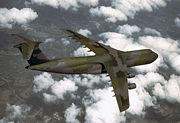
In the early 1970s, the C-5 was considered for the role of Shuttle Carrier Aircraft to transport the Space Shuttle to Kennedy Space Center by NASA, but rejected in favor of the Boeing 747 due in part to the 747's low-wing design. In contrast, the Soviet Union chose to transport its shuttles using the high-winged An-225, which is derived from the An-124, which is very similar to the C-5 in terms of design and function.
During static and fatigue testing, cracks in the wings occurred before completion of testing. All C-5A aircraft were restricted to 80% of maximum design loads. To reduce wing loading, load alleviation systems were added to the aircraft.[3] By 1980, payloads were restricted to as low as 50,000 lb (23,000 kg) for general cargo during peacetime operations. To restore full payload capability and service life, a program to rewing the 76 C-5As began in 1976. After design and testing of the new wing design, the C-5As received their new wings from 1980 to 1987.[4]
The first C-5B was delivered to Altus Air Force Base in January 1986. In April 1989, the last of 50 C-5B aircraft was added to the 77 C-5As in the Air Force's airlift force structure. The C-5B includes all C-5A improvements and numerous additional system modifications to improve reliability and maintainability.[5]
In 1998, the Avionics Modernization Program (AMP) began upgrading the C-5's avionics to include a glass cockpit, navigation equipment, and a new autopilot system.[6] Another part of the C-5 modernization effort is the Reliability Enhancement and Re-engining Program (RERP). The program will mainly replace the engines with newer, more powerful ones. Three C-5s are to undergo RERP as a test with full production planned to begin in May 2008.[7]
Design

The C-5 is a large high-wing cargo aircraft. It has a distinctive high T-tail, 25 degree wing sweep, and four TF39 turbofan engines mounted on pylons beneath the wings. The C-5 is similar in appearance to its smaller predecessor, the C-141 Starlifter. The C-5 has 12 internal wing tanks and is equipped for aerial refueling. It has both nose and aft doors for "drive-through" loading and unloading of cargo.[8]
The C-5 features a cargo compartment 121 feet long, 13.5 feet high, and 19 feet wide (37 m by 4.1 m by 5.8 m), or just over 31,000 ft³ (880 m³). The compartment can accommodate up to 36 463L master pallets or a mix of palletized cargo and vehicles. The cargo hold of the C-5 is actually a foot longer than the length of the first powered flight by the Wright Brothers' flyer at Kitty Hawk. The nose and aft doors open the full width and height of the cargo compartment to permit faster and easier loading. Ramps are full width at each end for loading double rows of vehicles. The volume of unusable space in a C-5's tail assembly (aft of the ramp) is larger than the available cargo space of a C-130 Hercules.[8]
It has an upper deck seating area for 73 passengers. The passengers face the rear of the aircraft, rather than forward. Its take off and landing distances, at maximum gross weight, are 8,300 ft (2,530 m) and 4,900 ft (1,490 m) respectively. Its high flotation landing gear has 28 wheels to share the weight. The "kneeling" landing gear system permits lowering of the parked aircraft so the cargo floor is at truck-bed height to facilitate vehicle loading and unloading.
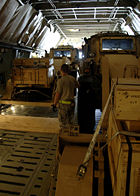
The C-5 has a MADAR (Malfunction Detection Analysis and Recording), a system that records and analyzes information and detects malfunctions in more than 800 test points. The C-5 is also known as "FRED" (Fucking Ridiculous Economic/Environmental Disaster) by its crews due to its maintenance/reliability issues and large consumption of fuel. The C-5 requires an average of 16 hours of maintenance for each flight hour based on 1996 data.[9]
The Galaxy is capable of carrying nearly all of the Army's combat equipment, including bulky items such as the 74 ton armored vehicle launched bridge (AVLB), from the United States to any location on the globe.[8]
Operational history
The first C-5A was delivered to the USAF on 17 December 1969. Wings were built up in the early 1970s at Altus AFB, OK; Charleston AFB, Dover AFB, DE; and Travis AFB, CA. July 9, 1970 marked the C-5's first mission in Southeast Asia during the Vietnam War. Through the rest of the war, C-5s were used to transport equipment and troops. Equipment included Army tanks, and various aircraft.[10] C-5s also delivered weapons and supplies to Israel as part of Operation Nickel Grass in 1973.[11]
During the 1980s the C-5As were re-winged to restore full design capability.[4] The US Air Force took delivery of the first C-5B on 28 December 1985 and the final one in April 1989.[12]

The C-5 is the largest aircraft to ever operate in the Antarctic. Williams Field near McMurdo Station is capable of handling C-5 aircraft and the first C-5 landed there in 1989.[13]
Fourteen C-5As have been retired as of 2005. Aircraft number 69-0004 was the first, sent to the Warner-Robins Air Logistics Center (ALC) for tear down and inspection. Data from inspection will be used to evaluate structural integrity and estimate remaining fleet lifespan. Thirteen C-5As were sent to the Air Force's Aerospace Maintenance and Regeneration Group (AMARG) for inspection. At AMARG, 66-8306 underwent tear down and inspection similar to 69-0004 at WR-ALC. The remaining 12 will eventually be reclaimed as destructive inspection is performed on the airframes to test for corrosion and fatigue.[14]
Sources have cited that the Air Force might be looking to replace some of these aircraft and have expressed interest in a military version of the new Airbus A380.[15]
Variants
C-5A

The C-5A is the original version of the C-5. From 1969 to 1973, 81 C-5As were delivered to US Air Forces bases. Due to cracks found in the wings in the mid-1970s, the cargo weight was restricted. To restore the plane's full capability, the wing structure was redesigned. A program to install new strengthened wings on 77 C-5As was conducted from 1981 to 1987. The redesigned wing made use of a new aluminum alloy that didn't exist during the original production.[16]
C-5B
The C-5B is an improved version of the C-5A. It incorporated all modifications and improvements made to the C-5A with improved wings, upgraded TF-39-GE-1C turbofan engines and updated avionics. From 1986 to 1989, 50 of the new variant were delivered to the US Air Force.[17]
C-5C
The C-5C is a specially modified variant for transporting large cargo. Two C-5s (68-0213 and 68-0216) were modified to have a larger internal cargo capacity to accommodate large payloads, such as satellites for use by NASA. The major modifications were the removal of the rear passenger compartment floor, splitting the rear cargo door in the middle, and installing a new movable aft bulkhead further to the rear.[18] Modifications also included adding a second inlet for ground power which can then be used to feed any power-dependent equipment which may form part of the cargo. The two C-5Cs are operated by US Air Force crews on the behalf of NASA, and are stationed at Travis AFB, CA. 68-0216 completed the Avionics Modernization Program in January 2007.[19]
C-5M

Based on a recent study showing 80% of the C-5 airframe service life remaining, AMC began an aggressive program to modernize all remaining C-5Bs and C-5Cs and many of the C-5As. The C-5 Avionics Modernization Program (AMP) began in 1998 and includes upgrading avionics to Global Air Traffic Management compliance, improving communications, new flat panel displays, improving navigation and safety equipment, and installing a new autopilot system. The first flight of the first modified C-5 with AMP(85-0004) occurred on December 21, 2002.[20]
Another part of the plan is a comprehensive Reliability Enhancement and Re-engining Program (RERP), which includes new General Electric CF6-80C2 engines, pylons and auxiliary power units, with upgrades to aircraft skin and frame, landing gear, cockpit and the pressurization system.[7] The CF6 engine produces 22% more thrust (for a total of 54,000 lb (240 kN) from each engine) than existing C-5 engines which will result in a 30% shorter take-off roll, a 38% higher climb rate to initial altitude, a significantly increased cargo load, and a longer range between refueling.[7][21] The C-5s that complete these upgrades are designated C-5M Super Galaxy.[22]
The C-5 AMP and RERP modernization programs plan to raise mission-capable rate to a minimum goal of 75%.[7] Over the next 40 years, the U.S. Air Force estimates the C-5M will save over US$20 billion.[23] The first of 111 planned C-5M conversions was completed on May 16, 2006, and performed its first flight on June 19, 2006.[23]
C-5Ms have been in flight testing out of Dobbins Air Reserve Base since June 2006. Two of the three (86-0013 and 86-0025) aircraft may be identified by the distinctive colored nose boom used to acquire test data.[6] As of February 2008, the USAF will convert all remaining C-5Bs and C-5Cs into C-5M with avionics upgrades and re-engining.[24] The C-5As will receive only the avionics upgrades.[25]
Operators
Unlike its Soviet (Ukrainian) counterpart, the civilian- and military-operated Antonov An-124 Ruslan or An-225 Mriya, use of the C-5 is confined entirely to the military and government use.

- 60th Air Mobility Wing, Travis Air Force Base, California
- 22d Airlift Squadron
- 97th Air Mobility Wing, Altus Air Force Base, Oklahoma
- 56th Airlift Squadron
- 105th Airlift Wing, (ANG), Stewart ANGB, New York
- 137th Airlift Squadron
- 164th Airlift Wing, (ANG), Memphis International Airport, Tennessee[26]
- 155th Airlift Squadron
- 167th Airlift Wing, (ANG), Martinsburg, West Virginia
- 167th Airlift Squadron
- 349th Air Mobility Wing, Travis Air Force Base, California
- 312th Airlift Squadron
- 433d Airlift Wing, Lackland Air Force Base, Texas
- 68th Airlift Squadron
- 356th Airlift Squadron
- 436th Airlift Wing, Dover Air Force Base, Delaware
- 9th Airlift Squadron
- 439th Airlift Wing, Westover Air Reserve Base, Massachusetts
- 337th Airlift Squadron
- 445th Airlift Wing, Wright-Patterson Air Force Base, Ohio
- 89th Airlift Squadron
- 512th Airlift Wing, Dover Air Force Base, Delaware
- 709th Airlift Squadron
- USAF operates 2 C-5Cs for NASA.
Incidents and accidents
There have been five C-5 Galaxy aircraft lost in crashes along with two class-A losses resulting from ground fire and one loss resulting from damage sustained on the ground. There have been at least two other C-5 crashes that resulted in major airframe damage, but the aircraft were repaired and returned to service.
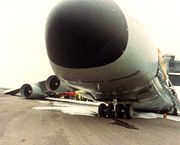


Notable accidents
- Aircraft 67-0172 (C-5A) was destroyed during a ground fire at Palmdale, California on May 25, 1970 after an ATM (Air Turbine Motor) started backwards and quickly overheated, setting the hydraulic system on fire and quickly consuming the aircraft. The engines were not running at the time of the fire and no one was injured.[27]
- Aircraft 66-8303 (C-5A) was destroyed during a ground fire at Marietta, Georgia on October 17, 1970. The fire started during maintenance in one of the aircraft's 12 huge fuel cells. One worker was killed and another injured. This was the first C-5 aircraft produced.[27]
- Aircraft 68-0227 (C-5A) was the first operational loss of a C-5 Galaxy. On September 27, 1974 the aircraft crashed after over-running the runway at Clinton, Oklahoma Municipal Airport during an emergency landing following a serious landing gear fire. The crew mistakenly aligned the aircraft for the visual approach into the wrong airport, landing at Clinton Municipal which has a 4,400 ft (1340 m) runway, instead of Clinton-Sherman airfield which has a 13,500 ft (4115 m) runway.[27]
- Aircraft 68-0218 (C-5A) was involved in one of the most well known C-5 accident to date. On April 4, 1975, the aircraft crashed while carrying orphans out of Vietnam (Operation Baby Lift). The crash occurred while trying to make an emergency landing at Tan Son Nhut Air Base Saigon, following a door lock failure in flight. 144 adults and children (including 76 babies) were killed out of the 305 aboard (243 children, 44 escorts, 16 crewmen and 2 flight nurses).[27]
- Aircraft 70-0446 (C-5A) crashed on landing at Shemya, Alaska on 31 July 1983. No fatalities. The airplane approached below the glideslope, hit an embankment short of the runway and bounced back into the air before coming to rest on the runway. Structural damage was extensive. The airplane keel and two structural mainframes were broken, and the two aft main landing gear bogies were sheared from the airplane (one remaining in the embankment, the other pushed up through the fuselage and came to rest inside the cargo compartment. A joint USAF/Lockheed team made repairs enabling a one-time ferry flight from Shemya to the Lockheed plant in Marietta. In Marietta, the airplane was quickly christened “Phoenix II” and permanent repair efforts got underway. In addition to the structural repairs, “Phoenix II” also received an improved landing gear system (common to the then-new C-5B), wing modification, and a color weather radar upgrade. The airplane was returned to service, and was transferred to the Texas Air National Guard.[28]
- Aircraft 68-0216 (C-5A) from Travis Air Force Base landed wheels up at Kelly AFB, July 1985. No injuries. The accident occurred while the crew was performing touch-and-go landings, the cause being a failure to lower the landing gear during the final approach of the day. The aircraft received significant damage to the lower fuselage and main landing gear pods. The C-5A was flown to Marietta for repairs. While in Marietta, the aircraft was selected to be the first C-5A converted to the C-5C configuration. [29]
- Aircraft 68-0228 (C-5A) crashed following an engine failure shortly after take-off. On August 29, 1990, the aircraft took off from Ramstein Air Base in Germany in support of Desert Shield. It was flown by a 9-member reserve crew (who had all volunteered to fly the mission) from the 68th Airlift Squadron, 433d Airlift Wing based at Kelly AFB, Texas. As the aircraft started to climb off the runway, one of the thrust reversers suddenly deployed. This resulted in loss of control of the aircraft and the subsequent crash. Of the 17 people on board, only 4 survived the crash. All four were in the rear troop compartment. The sole crewman to survive, Staff Sgt Lorenzo Galvan Jr, was awarded the Airman's Medal for his actions in evacuating the survivors from the wreckage.[27]
- Aircraft 84-0059 (C-5B) crashed after an in-flight emergency involving an indication that a thrust reverser was not locked. On April 3, 2006, the aircraft, assigned to the 436th Airlift Wing and flown by a reserve crew from the 709th Airlift Squadron, 512th Airlift Wing crashed about 2000 ft (610 m) short of runway 32, while attempting a heavyweight emergency landing at Dover Air Force Base, Delaware. The airplane, carrying 17 people, had taken off from Dover about 21 minutes earlier and reported an in-flight emergency (number 2 engine thrust reverser not locked indication) 10 minutes into the flight. All 17 aboard survived, 15 with no injuries, 2 with serious. The Air Force's accident investigation concluded the crash was a result of human error, most notably the determination that the crew kept one of the functioning engines in flight idle while manipulating the throttle of the (dead) number 2 engine as if it was still running, while having the no.3 engine at idle, an error that was further amplified by the crew's decision to use a high flap setting that increased drag beyond normal 2 engine performance capabilities.[30] The forward fuselage will be converted into a C-5 AMP avionics test bed, and the rest of the airframe has been scrapped.[31] USAF Crash Investigation Video can be viewed here.
Specifications (C-5B)

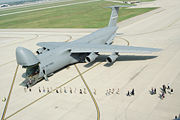
Data from USAF fact sheet,[32] Lockheed-Martin C-5,[33] and Quest for Performance[34]
General characteristics
- Crew: 8 typical (Pilot, first pilot, copilot, two flight engineers, three loadmasters)
4 minimum (Pilot, copilot, two flight engineers) - Payload: 270,000 lb (120,000 kg)
- Length: 247 ft 1 in (75.3 m)
- Wingspan: 222 ft 9 in (67.89 m)
- Height: 65 ft 1 in (19.84 m)
- Wing area: 6,200 ft² (580 m²)
- Empty weight: 380,000 lb (170,000 kg)
- Loaded weight: 769,000 lb (349,000 kg)
- Max takeoff weight: 840,000 lb (381,000 kg)
- Powerplant: 4× General Electric TF39-GE-1C high-bypass turbofan, 43,000 lbf (190 kN) each
Performance
- Maximum speed: Mach 0.79 (503 knots, 579 mph, 931 km/h)
- Cruise speed: Mach 0.77
- Range: 2,400 nmi (2,761 mi, 4,445 km) with a 263,200 lb payload
- Service ceiling 34,000 ft (10.4 km)
- Rate of climb: 1,800 ft/min (9.1 m/s)
- Wing loading: 120 lb/ft² (610 kg/m²)
- Thrust/weight: 0.22
- Takeoff roll: 8,400 ft (2,600 m)
- Landing roll: 3,600 ft (1,100 m)
- Fuel capacity: 51,150 US gal (193,620 L)
See also
Comparable aircraft
Related lists
- List of active United States military aircraft
- List of Lockheed aircraft
References
- ↑ Mehuron, Tamar A., Assoc. Editor. 2008 USAF Almanac, Fact and Figures, Air Force Magazine, May 2008.
- ↑ 2.0 2.1 2.2 C-5 history, GlobalSecurity.org.
- ↑ Norton 2003, p. 31-36.
- ↑ 4.0 4.1 Norton 2003, p. 53-56.
- ↑ Norton 2003, p. 56-58.
- ↑ 6.0 6.1 Schanz, Marc V., Assoc. Editor (June 2007). "Life with the C-5". AIR FORCE MAGAZINE, Journal of the Air Force Association (Air Force Association) 90 (6): p.59–60. ISSN: 0730-6784. http://www.afa.org/magazine/june2007/0607C5.ASP.
- ↑ 7.0 7.1 7.2 7.3 Saving the Galaxy, Air Force Magazine, January 2004.
- ↑ 8.0 8.1 8.2 C-5 design, Globalsecurity.org
- ↑ C-5 Service Life, GlobalSecurity.org
- ↑ Norton 2003, p. 43-44.
- ↑ Norton 2003, p. 45-46.
- ↑ Norton 2003, p. 58.
- ↑ National Science Foundation (20 February 2002). "Runway Project Clears the Way for Improved Antarctic Airlift". Press release. Retrieved on 2007-01-20.
- ↑ AMARC C-5 Galaxy page, amarcexperience.com
- ↑ "US considers Airbus A380 as Air Force One and potentially a C-5 replacement", FlightGlobal.com, October 17, 2007.
- ↑ C-5A, GlobalSecurity.org
- ↑ C-5B, GlobalSecurity.org
- ↑ Norton 2003, p. 62, 78.
- ↑ C-5C, GlobalSecurity.org
- ↑ "First Flight For AMP C-5", Code One Magazine, April 2003.
- ↑ "Lockheed Martin C-5M "Super Galaxy" Expands U.S. Air Force "Global Reach" Capability at Lower Cost". Lockheed Martin. 16 May 2006.
- ↑ "Second C-5M Super Galaxy takes flight." Air Force Print News. November 20, 2006.
- ↑ 23.0 23.1 C-5 still going strong
- ↑ Warick, Graham. "Pentagon cancels re-engining of USAF's older Lockheed C-5s", Flightglobal.com, 15 February 2008.
- ↑ "Air Force C-5 Galaxy modernization program certified", US Air Force, February 15, 2008.
- ↑ TennANG 164th Airlift Wing
- ↑ 27.0 27.1 27.2 27.3 27.4 Dover AFB crash plus the other 5
- ↑ Lippincott 2006, p. 35
- ↑ Lippincott 2006, p. 28
- ↑ C-5 accident investigation board complete
- ↑ "Gone with the wings: C-5 removal process in full swing." Langley, N. Air Force News. January 19, 2007.
- ↑ C-5 Galaxy fact sheet, US Air Force, April 2008.
- ↑ C-5 Galaxy specifications, Lockheed Martin.
- ↑ Loftin, L. K., Jr. (1985). "Quest for performance: The evolution of modern aircraft. NASA SP-468".
- Norton, Bill. Lockheed Martin C-5 Galaxy, Specialty Press, 2003. ISBN 1-58007-061-2.
- Lippincott, Richard C-5 Galaxy in Action, Squadron/Signal Publications, 2006. ISBN 0-89747-504-6
External links
- C-5 Galaxy U.S. Air Force fact sheet
- C-5 Galaxy on LockheedMartin.com
- "C-5 Galaxy". Pike, J. GlobalSecurity.org
- C-5 Galaxy U.S. Air Force history page
- C-5 Galaxy and Starlifter page
- "C-5 Galaxy" on Air-Attack.com
- "USAF banks on Lockheed Martin C-5M Super Galaxy as workhorse until 2040", Jane's International Defence Review, July 2006.
|
||||||||
|
|||||
|
||||||||||||||
|
||||||||||||||